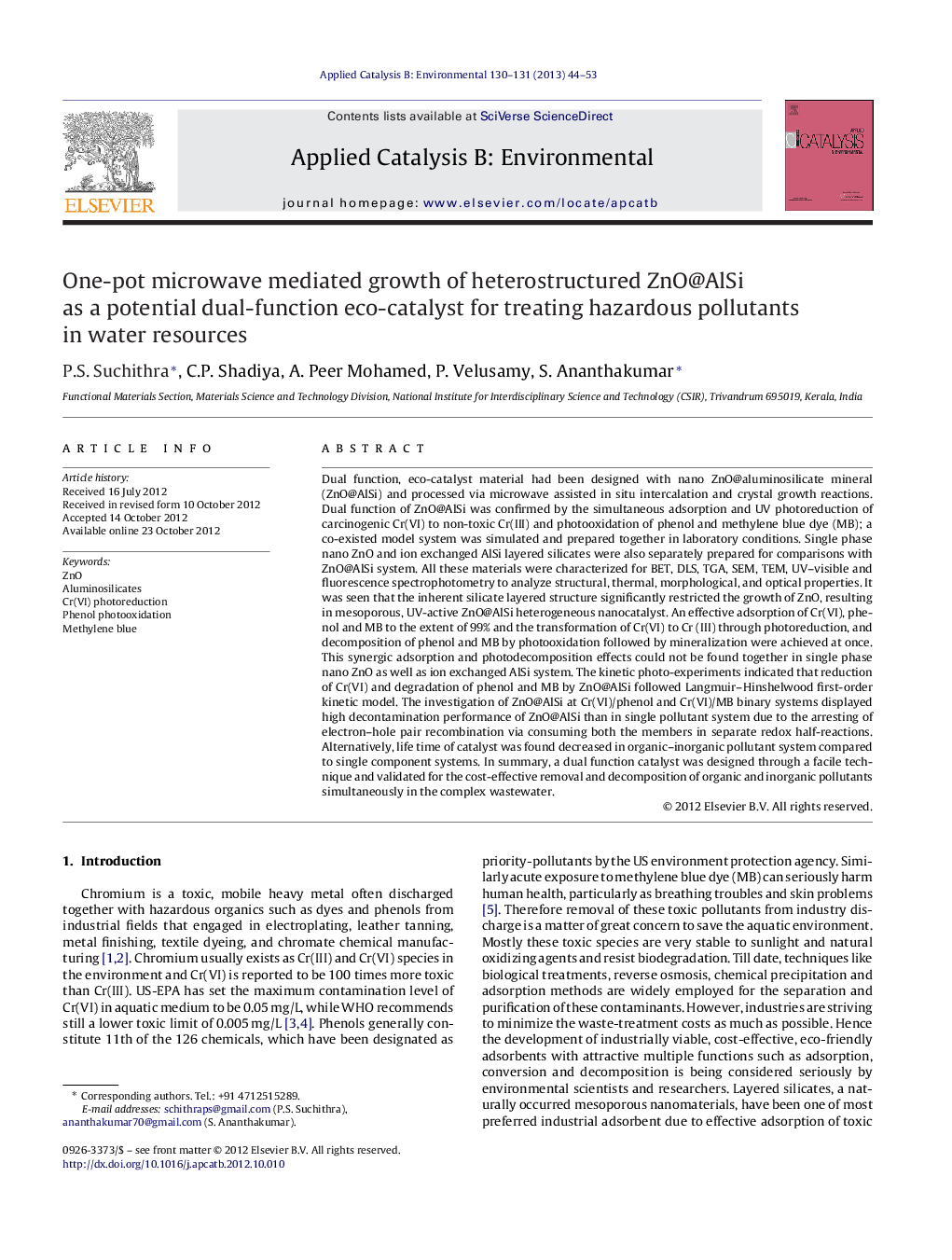| کد مقاله | کد نشریه | سال انتشار | مقاله انگلیسی | نسخه تمام متن |
|---|---|---|---|---|
| 45814 | 46423 | 2013 | 10 صفحه PDF | دانلود رایگان |

Dual function, eco-catalyst material had been designed with nano ZnO@aluminosilicate mineral (ZnO@AlSi) and processed via microwave assisted in situ intercalation and crystal growth reactions. Dual function of ZnO@AlSi was confirmed by the simultaneous adsorption and UV photoreduction of carcinogenic Cr(VI) to non-toxic Cr(III) and photooxidation of phenol and methylene blue dye (MB); a co-existed model system was simulated and prepared together in laboratory conditions. Single phase nano ZnO and ion exchanged AlSi layered silicates were also separately prepared for comparisons with ZnO@AlSi system. All these materials were characterized for BET, DLS, TGA, SEM, TEM, UV–visible and fluorescence spectrophotometry to analyze structural, thermal, morphological, and optical properties. It was seen that the inherent silicate layered structure significantly restricted the growth of ZnO, resulting in mesoporous, UV-active ZnO@AlSi heterogeneous nanocatalyst. An effective adsorption of Cr(VI), phenol and MB to the extent of 99% and the transformation of Cr(VI) to Cr (III) through photoreduction, and decomposition of phenol and MB by photooxidation followed by mineralization were achieved at once. This synergic adsorption and photodecomposition effects could not be found together in single phase nano ZnO as well as ion exchanged AlSi system. The kinetic photo-experiments indicated that reduction of Cr(VI) and degradation of phenol and MB by ZnO@AlSi followed Langmuir–Hinshelwood first-order kinetic model. The investigation of ZnO@AlSi at Cr(VI)/phenol and Cr(VI)/MB binary systems displayed high decontamination performance of ZnO@AlSi than in single pollutant system due to the arresting of electron–hole pair recombination via consuming both the members in separate redox half-reactions. Alternatively, life time of catalyst was found decreased in organic–inorganic pollutant system compared to single component systems. In summary, a dual function catalyst was designed through a facile technique and validated for the cost-effective removal and decomposition of organic and inorganic pollutants simultaneously in the complex wastewater.
Mesoporous, hybrid ZnO@AlSi, consisted of nanoparticulate zinc oxide embedded in aluminosilicate matrix acted as a cost-effective ecocatalyst with dual function as adsorbent and photocatalyst. The catalyst was very effective for detoxification of multicomponent complex wastewater containing both hazardous organic and inorganic pollutants through synergic adsorption, photo reduction and photooxidation effects consecutively for three cycles.Figure optionsDownload as PowerPoint slideHighlights
► Eco-catalyst via microwave assisted in situ intercalation and crystal growth.
► Mesoporous, heterostructured ZnO@aluminosilicate as adsorbent and photocatalyst.
► Photoreduction of carcinogenic Cr(VI) to non-toxic Cr(III).
► Mineralization of phenol and methylene blue via photodecomposition.
► Synergic photoeffect for treating multicomponent pollutant systems.
Journal: Applied Catalysis B: Environmental - Volumes 130–131, 7 February 2013, Pages 44–53